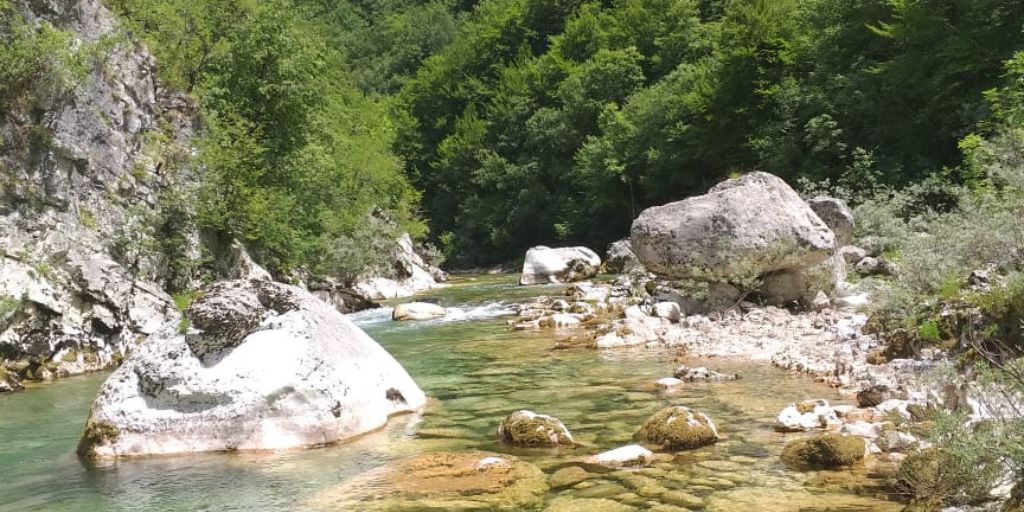The EU’s house bank has recently updated its exclusion list, a document detailing what kind of projects it will not finance. This finally closes a long-standing loophole allowing ill-suited intermediaries to finance hydropower projects.
Pippa Gallop, Southeast Europe Energy Advisor | 29 July 2022

The Komarnica Canyon, Montenegro Photo: Stefan Durutović
During the last few years, we’ve gradually discovered the involvement of the European Investment Bank in more and more small hydropower projects in southeast Europe, financed via commercial or national development bank intermediaries.
These include the Mojanska plants in Montenegro, the Tresonecka and Brza Voda plants in North Macedonia, the Beli Kamen and Komalj plants in Serbia, the Ilovac plant in Croatia, and the Blagoevgradska Bistritsa plants in Bulgaria.
What we have managed to piece together is that the EIB has provided at least 27 loans for hydropower plants through financial intermediaries in the region since 2010, though the exact number and many of the names of the plants remain unknown.
Intermediaries are secretive for a reason
The EIB doesn’t require its bank intermediaries to publish the names of the projects they finance (unless they are worth above EUR 50 million, which they rarely are), and only discloses the names of the projects financed if the intermediary consents.
It is not surprising that many intermediaries don’t want to advertise their involvement in small hydropower projects. Hundreds of plants have mushroomed across the region in the last two decades, many of them in the region’s most remote and pristine areas. Leaving rivers dry and robbing people of water for cattle, irrigation or even drinking, no other infrastructure projects have attracted such widespread public resistance across southeast Europe.
Arms-length investments
EIB investments are required to meet EU standards, but in the case of projects financed via intermediaries, it is usually up to the intermediaries to ensure this. What has become obvious in the last few years, is that commercial and national development banks in southeast Europe are far from able or willing to do so.
Most of the hydropower plants named above are in protected areas, yet not all were even subject to environmental impact assessments and where they were, they were of appalling quality.
When we have raised concerns with the EIB about the projects, the Bank has not been willing to take corrective action, stating that the intermediary is responsible for due diligence and monitoring and that the national authorities are responsible for environmental enforcement. While this may be true in theory, in practice it often turns out that neither the intermediaries nor the authorities are doing their job.
New exclusion rules
Earlier this year, the EIB published its new environmental and social policy and standards. Despite the much-awaited inclusion of specific standards for financial intermediaries, not much changed for intermediated projects.
Now, however, the Bank has updated a complementary document called the EIB eligibility, excluded activities and excluded sectors list, which updates a similar document from 2013.
It states, among other things, that ‘While detailed EIB due diligence may lead to the approval of such projects in some circumstances, in general final beneficiaries whose main activity is in the following sectors are excluded from multi-beneficiary intermediated loans and other intermediated debt products’. The sectors listed include mining, waste incineration and hydropower, among others, meaning that bank intermediaries can no longer finance hydropower projects without the EIB directly carrying out detailed project checks itself.
Similar rules which entered force at the beginning of 2020 at the EBRD have shown that in reality, intermediaries mostly won’t want to go through the extra hassle of additional due diligence and will stick to lower-risk projects instead. This is great news for rivers in southeast Europe and elsewhere.
Existing projects still need attention
The fact that the EIB has recognised the problem and stemmed the flow of financing to hydropower via intermediaries is highly welcome. But the projects which have already been built still need the Bank’s attention in order to mitigate their worst impacts. The EIB cannot simply walk away from the fact that its money was instrumental in making these projects happen and needs to play its part in at least ensuring that adequate water levels are left in the riverbeds.
The Save the Blue Heart of Europe campaign aims to protect the most valuable rivers in the Balkans from building hydropower plants. The campaign is coordinated by the NGOs Riverwatch and EuroNatur, and is being run jointly with partner organisations from the Balkans.
Never miss an update
We expose the risks of international public finance and bring critical updates from the ground – straight to your inbox.
Institution: EIB
Theme: Hydropower |
Tags: Environmental Impact Assessment | Natura 2000 | Western Balkans | hydropower
